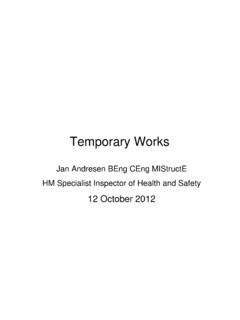Transcription of White Paper: Innovative FTTH Deployment Technologies
1 White Paper: Innovative ftth Deployment Technologies By the Deployment & Operations Committee Co-ordinators: Tony Stockman, Condux; Rong Zhao, Detecon International Contributors: Graham Dupree, Clearfield Inc.; Jan Dewinter, Maxcell Group; Tony Eaves, Fearless Digital; Andy Harris, Atlantis Hydrotec; Dan Jenkins, M2FX Ltd.; Erik Klein Nagelvoort, Jelcer Networks ; Claus Nygaard, GM Plast; and Christoph Pauselius, Pauselius Consulting; and Pauline Rigby, Technology Writer. 2 Table of Contents Introduction .. 3 Innovative Infrastructure Sharing .. 5 Duct sharing in France .. 5 Sewer pipes .. 6 Drinking water pipes .. 7 Residential gas pipes .. 10 Innovative Fibre Installation Methods .. 11 Handheld fibre blowers .. 11 Pushable fibre .. 13 Cable de-coring .. 14 Innovative ftth Components .. 15 Flat microduct systems.
2 15 No epoxy, no polish connectors .. 17 Pre-terminated cable .. 18 Innovative Project Design .. 20 Case Study: Parham, UK .. 20 Avoiding highways and associated costs .. 21 Design for customer self-connection .. 22 Cost breakdown of the Parham ftth Project .. 24 Conclusion .. 26 3 Introduction The pace of investment in fibre access networks in Europe has been relatively slow, especially compared to other regions in the world such as Asia Pacific, Middle East and North America. The business case can be particularly difficult to put together in countries that typically have high costs for new network construction. The debate isn t about whether a fibre to the home network is the best choice everyone agrees that it is the ideal technological solution. The debate now centres on how to build a network that isn t too costly to deploy or operate.
3 The investment required can vary considerably depending on the geography being served. Sparsely populated rural areas are the most expensive to connect, because of the long distances to homes. Urban environments are more densely populated, but they also present construction challenges, especially where there is limited space in existing duct infrastructure. Regardless of geography, the construction (or civil works as they are often called) is the most expensive part of the project. Some estimates put it as high as 80 percent of the overall cost. The construction work therefore offers the greatest scope for reducing the cost of building the network. The construction costs are loaded into the early years of the business plan. Reducing the construction costs will make the business case more attractive to investors, which will in turn speed up the pace of ftth Deployment .
4 In this paper we consider Innovative methods and equipment that can reduce ftth Deployment costs. The word Innovative suggests alternative methods that are being used by the few rather than the many. The Deployment methods, equipment, and products described in this paper are not yet in widespread use although that may well change with time. Over the last few years, alternatives to traditional trenching methods have emerged. Some, such as micro-trenching and directional drilling, have quickly become accepted and are already considered part of the arsenal of standard techniques. The alternative construction techniques and equipment described in this paper can lower the construction costs of the optical distribution network ( the part of the network outside the home or building). In each case, we shall explain the technique or equipment and identify its advantages and limitations.
5 4 The most obvious way to reduce the scope of civil works is to use existing buried infrastructure, such as the duct network of the incumbent operator. In practice, duct sharing has been deployed less often than one might expect, and its application is still quite novel in many countries. We look at the situation in France to see how duct sharing has been enabled there. Infrastructure belonging to other utilities, such as the sewer system, gas main or water pipes, also provides possibilities for infrastructure sharing both in the feeder part of the network and in the final drop to homes. A method even exists to re-use coaxial cables as conduit for optical fibre. The speed and ease of installation also has a bearing on the project costs. New equipment has been developed that makes it possible to install cable into ducts more quickly using fewer engineers.
6 Innovative components enable swift installation of ducts, branches and connectors to high standards but without specialised tools. Finally, we consider a project in a rural area where several novel ideas were applied. These included avoiding construction in highways altogether, instead opting for trenching in farmers fields, and a self-install pack for the customer, who must make the final connection from a boundary box at the edge of the property to the home itself. A selection of Innovative techniques and equipment will be described, but it is not intended to be comprehensive. For a more complete and thorough overview of the subject of ftth Deployment , please see the ftth Handbook, also produced by the Deployment & Operations Committee of the ftth Council Europe. While cost of fibre Deployment is only one aspect of the business case, it is an important one.
7 Reducing the cost of Deployment could dramatically speed up the pace of ftth roll out in Europe. 5 Innovative Infrastructure Sharing Duct sharing in France The sharing of the duct and pole infrastructure of the incumbent telecom operator is an obvious way to drive down the roll out cost of ftth networks. In France, the regulatory authority defined rules for duct sharing, and the access process was agreed in 2008. Since then the main alternative operators Free, SFR, and Numericable have stopped all civil works to create their own duct infrastructure and started to deploy their cables in the ducts belonging to the incumbent operator Orange (France Telecom). There are two principles to be observed: cables from different operators in the same duct must be physically separated (which requires sub ducting), and the operator who deploys a cable needs to guarantee there is enough remaining capacity in a given duct section so that his competitor can deploy a cable of the same size in the same section.
8 Since several operators are now using a duct infrastructure that originally was designed for only one operator, it is important to use the remaining duct capacity in the most efficient way. The fee for renting duct space from Orange is directly correlated with the cross-sectional area of the cable that is installed. This drives alternative operators to use smaller cables that take up less space. In duct sections with limited remaining space, flexible textile sub ducts can be used. Flexible textile inner ducts take up three times less space than rigid inner ducts, which maximises the number of cables that can be installed. Flexible inner ducts can also be used where rigid ones would normally be used but have failed during installation because the duct was filled with dirt or partially crushed. Figure 1: Flexible inner ducts maximize the use of duct space.
9 6 In the picture (previous page) is a 100-mm inner diameter duct containing three rigid sub ducts designed to hold three cables, but with a lot of wasted space. The use of flexible inner duct makes it possible to add more cables to this already congested duct -- three in this case, from three alternative operators. Without flexible inner ducts this duct would be full. It is estimated that about billion was saved over five years by eliminating civil works for new cables in France, and similar savings could be made in the coming five years. The huge cost savings from duct sharing can dramatically improve the return on investment for ftth projects. In some cases projects have been executed that would otherwise not have been possible. Although duct sharing is possible in most of European countries and billions in savings could be realized, as they have been in France, the approach is not widely used.
10 The key factors which resulted in general acceptance and the adoption of infrastructure sharing in France were the French government s clear vision about the need for ultra-high-speed broadband networks and an empowered, independent telecom regulator, ARCEP, which facilitated the whole process and watched over the feasibility and technical and financial balance of the agreement. Sewer pipes Waste water pipes are virtually ubiquitous. In the Netherlands, nearly 99% of the population is connected to urban waste water treatment. Other European countries, such as Austria, Germany, Spain and the UK, have connected more than 90% of their populations to waste water treatment. Using the existing sewer system to install fibre-optic cables, it is possible to reach more residents. Sewers are also buried deeply in the ground, making them less vulnerable to accidental damage.




